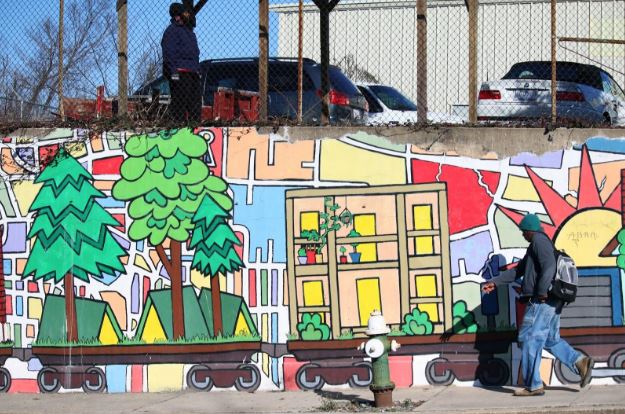GREENSBORO, N.C. - Charismatic murals and scattered art galleries invite people to explore and take part in the cultural transformation of Downtown Greensboro.
Deeply rooted in the Civil Rights Movement, the art scene in Greensboro exemplifies a balance between historical significance and growing urban influences.
Organizations such as Greensboro’s Elsewhere work to push both the development of downtown and the city’s art community. What began as a thrift shop in 1939 on South Elm Street has been transformed into a vibrant living art museum and creative hub. Elsewhere holds events to engage locals in the growing Greensboro art scene and invites residents from around the world to create work inspired by the decades worth of collected objects that remain fundamental to the space.
At Elsewhere’s recent fundraiser, Partners in City, Neighbors in Community (PICNIC), local artists presented their ideas for community art projects, in hopes of collecting the most votes to win the $1000 pot of donations.
One group, the Greensboro Mural Project, pitched its ideas for various future projects throughout the city with a focus on community engagement through art. The group invited PICNIC attendants to write their own “Love Letters to Greensboro,” which will influence the designs for five murals in each district.
George Scheer, director and co-founder of Elsewhere, said Greensboro’s sidewalk culture has been a major catalyst of the growth of both the organization and the city, from Elsewhere’s artists giving talks to pedestrians through sliding storefront windows before it had the proper building codes to facilitate events, to the painted hopscotch course that weaves throughout downtown sidewalks to Elsewhere’s door.
“Part of being here, inviting crowds, having events, really getting people to this side of the track was a big cultural shift in terms of getting people to think about how culture operates in Greensboro, even people’s desire to go out downtown,” Scheer said.
George Scheer, director and co-founder of Elsewhere, said the organization has been a key proponent for the downtown Elm Street area’s development, recognizing its role and responsibility as a cultural space in the community. “This whole block has transformed, and really downtown has been transformed," Scheer said. "And so we positioned ourselves as both a champion and a critic of that development.”
Elsewhere visitors take time away from PICNIC to create their own projects with materials provided by the museum. PICNIC is part of the “First Friday” events supported by the city, an initiative to encourage people to go downtown and engage with local businesses and artists on the first Friday of every month.
PICNIC presenters created informational posters and invited guests to better understand their project proposals while exploring the Elsewhere collection. “It’s having the programs that engage people but also recruitment to get the variety of projects that are presented,” Elsewhere director George Scheer said. “It requires developing grant programs that are about partnerships with nonprofits and social service organizations.”
Artist Sherrill Roland presents his project proposal, The Jumpsuit Project. After being incarcerated for three years, Roland wears an orange jumpsuit to class at UNC-Greensboro every day and invites campus community to share their own experiences about with incarceration. He was chosen as the winner of PICNIC and was awarded $750 to jump-start his project.
Elsewhere collected $1,000 in donations to award to the two winners, $750 for Sherrill Roland with The Jumpsuit Project and $250 for Cherizar Crippen with the Revolutionary Sunday School, which works to correct for disparities in the public education system curriculum and support the success of minority students.
The Greensboro Mural Project invited visitors of Elsewhere to write their own “Love Letters to the City,” which will influence the design of five murals in each of the city’s districts. The Project members said they actively work to combat the creative inequity in the city by seeking out community feedback and engagement to directly influence their artwork.
The Greensboro Mural Project created their first project outside the Interactive Resource Center. To get inspiration for the mural design, the artists asked community members, “What makes home?” and welcomed locals to pick up a paint brush and leave their mark on the final piece.
Adam Faust, an artist working with the Greensboro Mural Project, flips through and adds to the communal art journal at People’s Perk coffee shop, the next location for the Project’s mural. He said the Project aims to include community members throughout the entire process of creating their murals, from ideation to painting. For the People’s Perk mural, the group hosted an open mic event at the coffee shop for people to nominate female figures to appear in the final design.
Sheryl Oring opens her portable office and encourages Elsewhere visitors to write their letters to the president as part of the museum’s mission of an inclusive art stage. Elsewhere will display carbon copies of each postcard, and originals will be sent to the White House. “Creative resistance and the act of co-creating is even more important now in the Trump presidency,” said Alyzza May, co-founder of the Greensboro Mural Project.
Elsewhere director George Scheer said his grandmother, pictured in the art above its storefront window, ran the thrift store from 1939 to 1997 from an inventory of items from the Salvation Army and Goodwill. Much of the acquired collection of toys, jewelry, novels and other things remain on display in the museum and as inspiration for artist residency projects.
Scheer said though most of the Elsewhere residents come from out of the area, he and his staff dedicate much of the museum’s mission toward strengthening the local art community.
“We as a museum hold those [local] relationships really dear and we take effort to connect them,” said George Scheer. “I believe it’s another way of heightening the critical [creativity] of this community. It’s one thing to support within, but it’s also really important to get ideas from outside.”


